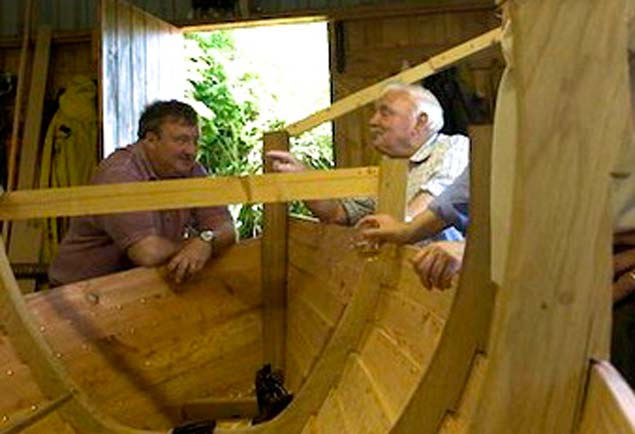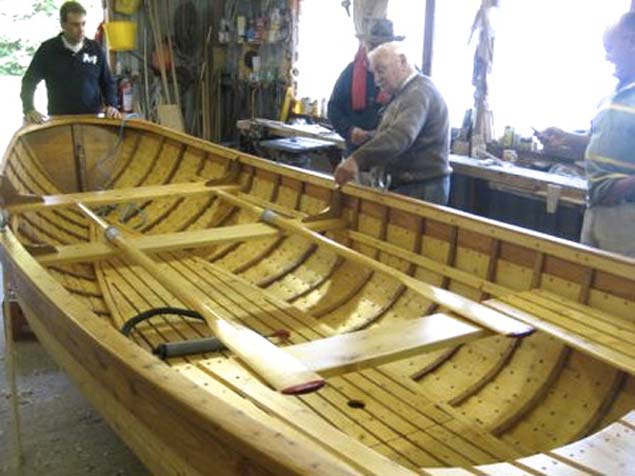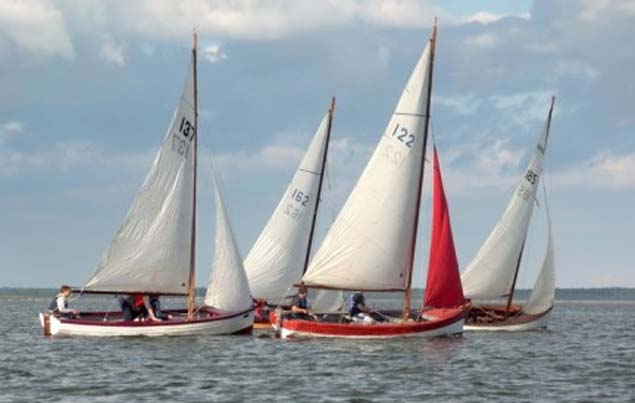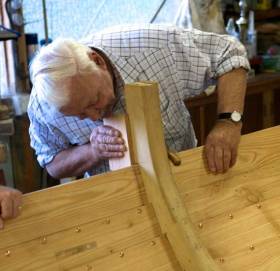Displaying items by tag: Larry Duggan
Larry Duggan 1927-2018 RIP
Larry Duggan, who has died this week at the age of 90, was one of the best-known and most popular figures in Wexford, and internationally renowned in the maritime world as a versatile builder of wooden boats of many kinds, all to the highest standards. But important as boats and the sea were to this energetic man, there was much more to him than that – he was even more than someone of many active interests, he was in reality a universe of activities, all pursued with enormous enthusiasm and dedication.
Born in Rosslare in 1927, with marriage to Margaret (Madge) the newly-married young couple settled in Wexford town, and their home for their final forty years together was at Carcur in their house called The Moorings on the south shore of the Slaney Estuary, in that pleasant area above the bridge near the Boat Club, where they raised their family of Laurence Jnr, the twins Tom and Will, and their daughter Ann.
Larry’s prime day job was as a builder and developer, but he also owned a saw-mill, for timber and working with it was one of his many passions. From an early age, his interest in boats was allied to this love of wood, resulting in a developing skill in boat-building projects which he undertook in whichever suitable workshops happened to be available to him in Wexford.
 However busy he might be, Larry Duggan (right) always had time to discuss the attractions of traditional boat-building
However busy he might be, Larry Duggan (right) always had time to discuss the attractions of traditional boat-building
It’s said of Larry Duggan that he was never still, and was always happiest when thinking of several things at once. Thus if he was on a house-building or carpentering job, he’d always be keeping a eye out for a piece of timber which might be better deployed in his evening’s boat-building activities.
As to how he managed all this, his son Will fondly recalled today that for his father, the 18-hour day was the norm, but he never regarded his long sessions of boat-building as work. In some ways, they were the very essence and expression of his life.
Yet somehow he found time for many other interests including ornithology, to which he invariably gave enthusiastic voluntary input. For instance, when the World Plough Championship was coming to Wexford, he was on the Organising Committee, and played a key role in the crucial task of laying out the top ploughing areas for the finalists.
On the maritime side, naturally he was a productive supporter of the RNLI and the Maritime Society, with his contribution being recognized by his award of the Maritime Medal. And his knowledge was such that when a Viking ship was to be built for the Wexford Heritage Park, when a team came from Scandinavia to oversee its construction, very quickly they found that a significant input from Larry Duggan was essential to the project’s successful conclusion.
 The finished product from Larry Duggan was always a joy to behold.
The finished product from Larry Duggan was always a joy to behold.
But his greatest joy in boat-building was in creating craft which had historic and contemporary Wexford links. He built many Wexford cots which, uniquely among the Irish river cot type, had developed a seagoing version – the Rosslare cot – in order to deal effectively with the many challenges for small working craft posed by the Slaney’s open and sandy estuary, and the sea immediately off it.
Then when local recreational sailing developed at the old area known as Maudin Town southeast of Wexford town itself, thanks to the fact that Larry had built three Dublin Bay Mermaids for the local fleet, he was able to secure second-hand Mermaid sails which could be re-cut for use in these neighbourhood boats, which have gone on to become distinctly turbo-powered versions of the traditional Wexford cot.
 The Wexford cots for receational sailing at an early stage of development, when Larry Duggan played a key role in building boats, sourcing second-hand sails, and teaching the basics of racing
The Wexford cots for receational sailing at an early stage of development, when Larry Duggan played a key role in building boats, sourcing second-hand sails, and teaching the basics of racing
 The contemporary Wexford sailing cot has continued to develop for racing purposes
The contemporary Wexford sailing cot has continued to develop for racing purposes
Not only did he help their crews to source sails, but he taught them to sail and race as well, for he was as able afloat with sails and boats as he was in the workshop building them. His skill was such that when the local estuary fish firm of Lett’s required a fleet of 24ft shoal-draft motor-boats to service their estuary fishing and shellfish beds, it was to Larry that they turned. It was quite a project for an “amateur” builder, but he succeeded so well that those boats continue to be a familiar and active sight in Wexford Harbour.
He cherished Wexford’s Irish traditions and Viking heritage alike, and when a special classic Viking skiff was required to be part of the Royal Silver Jubilee Celebration Fleet on the Thames in London, it was reckoned that Larry’s unique talents were ideal to create something with the essential authenticity, and he took extra pleasure in fulfilling this demanding “export” order.
His eightieth birthday celebrations in Wexford in 2007 provided one of the town’s most memorable parties, but retirement of any kind was far from Larry Duggan’s mind. He continued building boats until well into his eighties, and even as his 90th birthday approached, he was more than willing to open up his workshop to take on any small job involving work on wood for his many friends.
Sadly, his beloved Madge was to die age 89 in 2014, but for his 90th birthday on 12th August last summer, among a huge number of greetings was a personal message of goodwill from President Michael D Higgins. Now, the great and good Larry Duggan is gone from among us. But he leaves cherished memories with hundreds of people worldwide. Our thoughts are with his family and many close friends in their sad loss.
WMN





























































